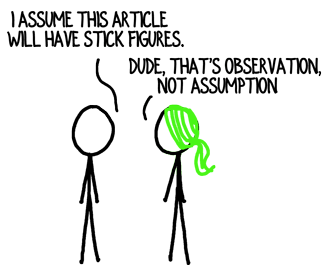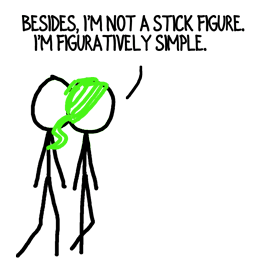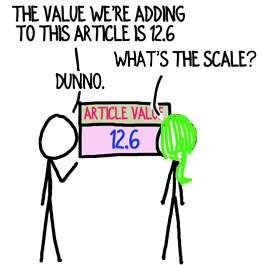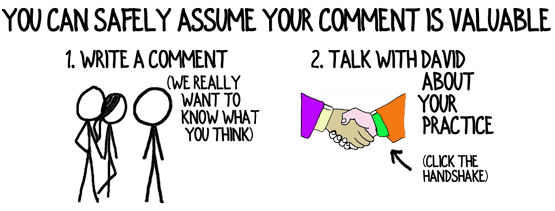You know the old adages about assumptions: “Assume makes an ass out of you and me,” and “Assume I’ll want chocolate when I visit, and you’ll be right,” and, of course, “Assume spelled sideways is almost masseuse.”
Assumptions alleviate the strain on your brain. You needn’t ponder the melting point of olive oil because you can safely assume it will remain liquid as long as you don’t refrigerate it.
Assumptions also save you time. You lose no minutes questioning whether a Pain au Chocolat is fattening because you assume it is. (Or pretend it isn’t.)

Since the amino acids of consulting are brain power and time, it’s little wonder that you aggressively employ assumptions to build your successful, lucrative consulting firm.
Unfortunately, assumptions can also trick you into poor decisions and suboptimal consulting behavior.
7 Assumptions that Might Be Sabotaging Your Consulting Firm
Assume Your Client is Wrong, Doesn’t Know, or is Faulty
Many consultants start a project with the a priori stance that their client has no clue. After all, if your client knew the right answers, he wouldn’t need to hire a consultant.
Sure, there may be a gap here or dysfunctional behavior there. But, clients generally have excellent information and perspective, and are, overall, operating quite well.
Break the Assumption: Take your consulting client’s positions, information and viewpoints as valuable input. Collaborate with him and use your combined knowledge and perspective to help him achieve success.
Assume You Know the Answer
If you dove deep during the discovery process (a good practice), you may feel like you’ve already discovered the solution. Also, if your current consulting client’s situation closely resembles a past client’s challenge, it’s easy to assume you can reapply the solution.
You owe it to your consulting client to not jump to conclusions.
Break the Assumption: Test past solutions in two ways: Testing whether your solution is right is easy. Also do the hard work of testing whether you solution may be wrong for your client.

Assume Your Client Understands You
Your discovery questions, your proposal, your mid-project emails, your deliverables and every other touch point between you and each client is swimming with opportunities to be misunderstood. It’s all too easy for a project to go South when your client’s understanding doesn’t match your intention.
Break the Assumption: Have a layperson read every document you send to your clients, then pay attention when they say something doesn’t make sense. It’s as annoying as a swarm of mosquitoes, but it works.
Assume That Logic Will Prevail
Your proposals, recommendations and solutions make sense. They’re logical. They’re best for your client. And that’s why it can be mystifying and frustrating when your client ignores you or rejects your suggestions outright.
Break the Assumption: Look for the emotional impact of your consulting work. How will your client personally gain or suffer? Who in your client’s organization might look bad? What’s going on in your client’s personal world that might be bleeding into his work life?
Assume Your Value is Obvious
From the moment you present your proposal for a consulting engagement to the moment(s) you deliver results, you increasingly believe your value is evident. (At least, if you’re doing good work and helping your client.)
In reality, your client may barely be paying attention to you. Plus, your client’s memory of every win you deliver has about the same half-life as a box of truffles. (About one week.)
Break the Assumption: Scorecard your results and regularly highlight the value you’re creating for your client.

Assume Your Values Are Best
Cultural assumptions pervade your consulting projects. They shape your approach, how you interact with your clients, the recommendations you develop, what you present and how you present it, and more.
At the extreme end, consider this: equality, meritocracy, honesty and transparency are hallmarks of Western cultures. But are those values necessarily “right” for your client?
Break the Assumption: Don’t gloss over culture. Take the time to learn about your client’s culture and why he thinks it’s good or best. You don’t have to agree with him, but you do need to be able to bridge any gaps between your worldview and his.
Assume… ?
I won’t presume I’ve caught all the assumptions that sabotage consulting firms, so this space is for you to add your views.
What other assumptions can sabotage consulting firms? Add your thoughts to the discussion below.
Text and images are © 2024 David A. Fields, all rights reserved.

 David A. Fields Consulting Group
David A. Fields Consulting Group 

Assuming your client will always use you and not look elsewhere for help. After several years of engagements, it us easy to assume you have that client locked down. That mentality can lead to laziness and a tendency to not keep in touch while you pursue other opportunities. All that does is potentially make other suitors more attractive. Stay on touch and treat them as you would a brand new client!
Good one, Dan! Spoken like an experienced consultant.
You’re absolutely right. It’s easy to become complacent and think a partnership today means a project tomorrow. Many small consulting firms derive 50% or more of their revenue from a single, anchor client. That’s a high-risk proposition. No client stays forever.
Stellar addition to the list of assumptions, Dan.
Being prepared to bring the project “back on track”. Often it is assumed that the project will proceed as agreed to initially, that the client fully understands the positive impact of all the incremental changes in their organization as the project proceeds. The client will want to deprioritize the project when other fires are drawing attention.
Great point, Kiran. It is easy to assume that projects will go well, even though it’s a rare project that follows the initial plan without any adjustments.
Similarly, as you said, clients’ priorities change and your client’s rabid attention today could morph into distant disinterest tomorrow if another fire takes his attention. Regular check-ins with your client will help you stay in touch with your current share of your client’s mind.
I appreciate you adding those important assumptions to the discussion, Kiran.
This is a terrific article. I’m guilty of most of these assumptions. If you’ve been in a single field for a long time (almost 30 years for me), it easy to believe that client challenges will fall into some solution that you have implemented one way or the other many times. Thanks for the reminder to take the time to really listen and respond to the unique characteristics of the client’s situation.
Cathy, we all fall into these assumptions. One of the first, painful lessons, my mentor in consulting taught me 20+ years ago was to look at your past successes as a source of ideas, not a library of solutions. I appreciate you joining the discussion and sharing your experience.
HI, David, great article!
I assume my clients are brilliant and know a lot, they are top level leaders/experts in their fields, as I am in mine. I don’t expect them to know mine, otherwise they do not need me. Actually I treat them as colleagues, which they like!
From respect, I learn their language, and speak in business terms, not in my jargon. I did not permit my grad. students to use jargon on their clients when I was a professor (Briefly! Not an academic by nature). This is great fun as I enjoy learning different sci/tech/engineering/healthcare languages fast, and clients appreciate it.
Nor do I think I have all the answers. Despite the proven power of my systems for 30 yrs., it is better if we co-create them, within the framework of those systems.
For 30+yrs, have used Myers-Briggs to ensure mutual understanding in exec. teams, and we use our differences intentionally for faster better results and change….we also laugh about our differences!
I only work with clients with the “Western” values you mention, as my approach only work with those values….one size does not fit all. The fit of consultant and client is crucial.
Regular de-briefs clarify and anchor the value of our work in their minds, plus annual reviews of our work. This also ensures they understand the cause and effect relationship of our work, essential when they are changing their behavior from a problem to a strengths focus…big culture shift.
Having almost all male executive clients, I know well logic does not always prevail, as men too are emotional, expressing it in their own subtle language, which I respect profoundly, as they can say so much in so few words. I have learned a lot from this. Those trained in the scientific method tend to be more rational, which makes the work easier, as they respect data collection and discovery and do not expect all the answers before those steps. The only client who ever threw me and my interview data out of his office was a Marketing exec. in a tech. firm. Took a few weeks but I turned him around, fiercely determined that they would not lose that medical market segment and billions in future revenue. It worked. Whew! I joke that I get all the easy jobs. 🙂
Again, great article! Fun to re-evaluate myself and my work against those criteria. I am thinking how I could do a bit more to advance their view of my value…hmmm.
Many thanks, Dr. Linne
You’ve given a great case study to learn from, Linne. Whether a consultant has a new practice, 13 years in the business or, like you, 30+ years, it’s still crucial to build solutions with clients based on the specifics of each client’s situation, desired outcomes, capabilities, etc.
Kudos to you for your perseverance and ability to build a long-term practice.
Assuming your client wants to change and has the ability to do so. In the industries in which I work, change is a rapid constant. Very often, this leads to clients who really do not want to change and want a palliative solution that will allow them not to. Don’t assume you can change human nature and emotions easily!
Absolutely right. Clients frequently can only deal with small doses of change. That’s why the ideal mix of “I knew that” vs. “Oh, that’s new” in a presentation to a client is around 90/10. On the other hand, even that assumption could be off base!
Assuming our clients actually want to change is a very good addition to the list, Simon.